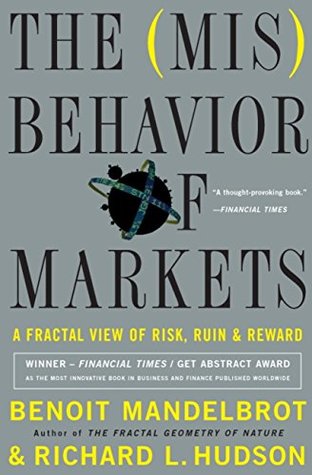More on this book
Community
Kindle Notes & Highlights
Read between
October 20 - October 26, 2020
The old financial orthodoxy was founded on two critical assumptions in Bachelier’s key model: Price changes are statistically independent, and they are normally distributed. The facts, as I vehemently argued in the 1960s and many economists now acknowledge, show otherwise.
Here, the underlying model is called fractional Brownian motion in multifractal time.
Anticipation is a feature unique to economics. It is psychology, individual and mass—even harder to fathom than the paradoxes of quantum mechanics. Anticipation is the stuff of dreams and vapors.
Mild randomness, then, is like the solid phase of matter: low energies, stable structures, well-defined volume. It stays where you put it. Wild randomness is like the gaseous phase of matter: high energies, no structure, no volume. No telling what it can do, where it will go. Slow randomness is intermediate between the others, the liquid state.
The P/E Effect. Financial analysts often compare a stock price to other numbers to help decide whether it is expensive or cheap. The most common tool is the price/earnings ratio: the stock price divided by the company’s per-share earnings.
In fact, several studies have found, stocks with high P/E ratios tend to perform worse than stocks with low ratios. That is, of course, just common sense: A stock for which you overpay from the start is less likely to give you a profit.
The Small-Firm-in-January Effect. Shortly after the P/E factor was studied, economists discovered the “January effect” mentioned earlier: a clear tendency of the market to rally every January. Then, a “small-firm effect” was discovered: Portfolios of small-company stocks outperformed large companies by 4.3 percent, economists found. And, further study found, a “small-firm-in-January” effect combining the two phenomena was even more pronounced than either on its own.
The Market-to-Book Effect. Another common financial ratio used by stock-pickers is market-to-book: That is, divide the stock price by the per-share value that the company’s accountants report in the financial reports, or “book.” Surprise: Companies with low ratios—that is, those that the stock market values less than does the company’s accountant—perform better over time than companies with high ratios. Of course, this is nothing more than the old Wall Street mantra, buy low, sell high. And
They looked at the price/earnings effect and the market/book effect—and found those two factors alone could account for most of what differentiated the profitability of one stock from another.
Fractal geometry is about spotting repeating patterns of this kind, analyzing them, quantifying them and manipulating them; it is a tool of both analysis and synthesis.
Power laws, the spread of rich and poor, and the mathematics of the exceptional stable probability distributions. One is a general way of looking at the world; the next a practical example of it in economics; and the last a set of mathematical considerations no one viewed as useful.
fat tails and discontinuity—and
Researchers in Zurich, working on their own scale for currency market crashes, found their index seemed to predict storms, albeit only over a short time-horizon. In the week of October 5–9, 1998, dollar/yen rates gyrated an extraordinary 15 percent. A few hours before the worst of the crisis, the researchers found, their index had soared from a level below 3 to one above 10. It “gave an early warning that the situation was very unstable,” they reported.
You cannot beat the market, says the standard market doctrine. Granted. But you can sidestep its worst punches.


